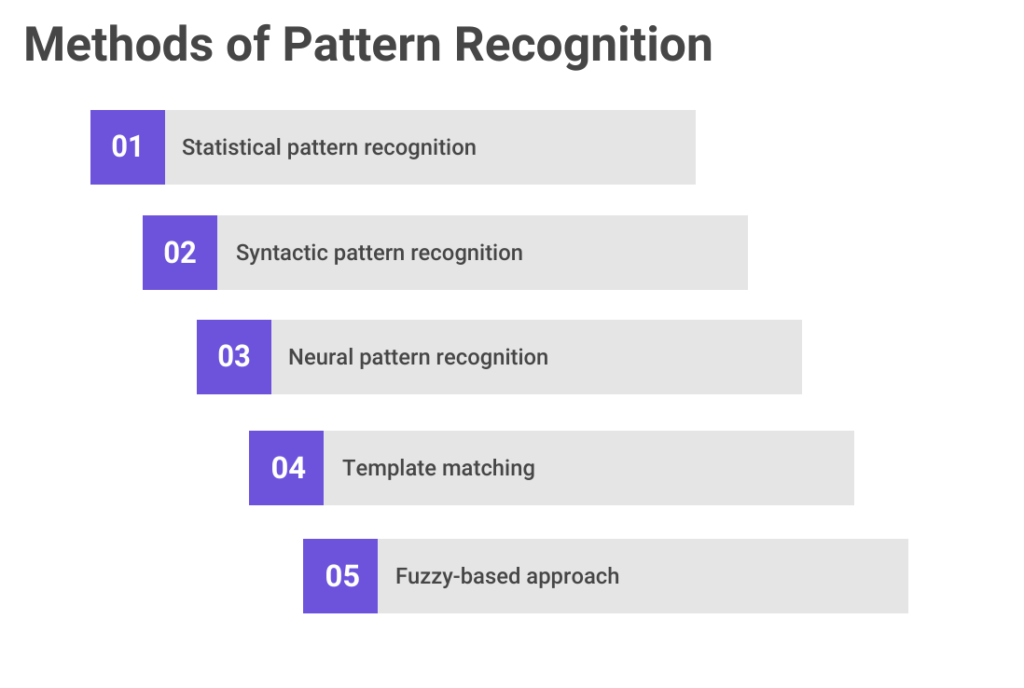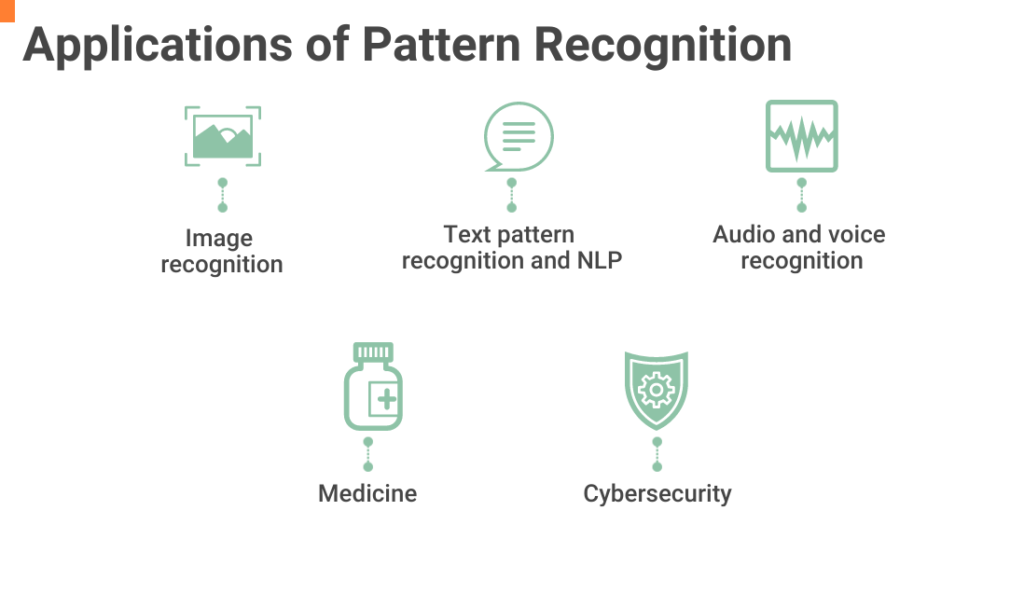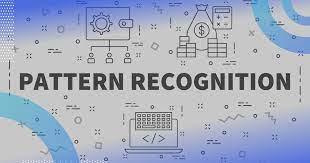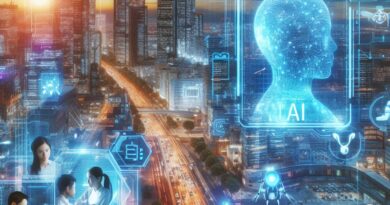Pattern Recognition: What Is It? Functioning, Types, and the application
Using computer algorithms, pattern recognition automates the process of finding regularities or patterns in data.
-The process of analysing data by applying machine learning algorithms to categorise incoming data into objects, classes, or categories according to patterns, characteristics, or regularities observed in the data is known as pattern recognition.
-It has various applications in robotics, astronomy, medicine, and satellite remote sensing, among other fields.
The fundamentals of pattern recognition, its operation, and its many uses are covered in this article.
What Is Pattern Recognition?
Using machine learning algorithms, pattern recognition is a data analysis technique that groups input data into objects, classes, or categories according to patterns, characteristics, or regularities found in the data. It has numerous uses in the domains of robotics, astronomy, medicine, and satellite remote sensing, among others.
There are two main classification techniques used in pattern recognition:
Monitored classification: A computer algorithm is trained by a human using predetermined labelled datasets to identify patterns in supervised pattern recognition techniques. The approach then classifies additional data after identifying the pattern.
Uncontrolled classification: The model learns on its own in unsupervised categorization without receiving direct human supervision. The computer method performs data classification and finds correlations between various data components (inputs) based on their similarity score.
There are various ways to implement pattern recognition. Even though it can be challenging to choose just one technique for completing identification duties, we’ll go over six well-liked approaches that corporations and professionals frequently employ for pattern recognition.

- Statistical pattern recognition
Utilising historical statistical data, this pattern recognition method picks up on trends and best practises. In order to define a model, the approach gathers observations and processes them. Next, this model applies the rules to fresh datasets or examples, generalising over the gathered observations.
- Syntactic pattern recognition
Complex patterns in syntactic pattern recognition can be found by employing a hierarchical method. The interactions between primitives, such as the letters that make up a word, are what create patterns. How primitives are put together to form words and phrases could serve as an illustration of this. The creation of grammatical rules that illustrate future sentence reading patterns will be made possible by these training samples.
- Neural pattern recognition
Using artificial neural networks (ANN), this technique recognises patterns, adjusts to data, and learns from intricate and non-linear input/output interactions. The feed-forward approach is the most widely used and successful neural network technique. Using this approach, input patterns receive feedback to facilitate learning. This is comparable to how people learn from their prior errors and experiences. Because it requires a lot of computational power, the ANN-based model is considered the priciest pattern recognition technique when compared to other techniques.
- Template matching
Among all pattern recognition techniques, template matching is the most straightforward. In this case, comparing the sample to the reference template yields the similarity between the two entities. These techniques are commonly applied in digital image processing, where a stored template picture is matched to small portions of an image. Face recognition, robot navigation, and medical image processing are a few real-world applications.
- Fuzzy-based approach
A group of patterns are divided using the fuzzy technique according to how similar their attributes are. Data can be quickly sorted into that established feature space when the distinctive characteristics of a pattern are accurately identified. Even after spending a significant amount of time studying an object, the human visual system occasionally fails to identify a particular component. The same is true in the digital realm, where objects’ precise natures cannot be determined by algorithms. Thus, the goal of the fuzzy approach is to categorise things using several comparable properties found in the patterns that are discovered.
- Hybrid approach
Using a hybrid strategy, all of these strategies are utilised in conjunction to maximise effectiveness. To find patterns, it uses several classifiers, each of which is trained on a different feature space. A determination is made by analysing the collective outcomes from each classifier.
How Does Recognition of Patterns Work?
Pattern recognition is used with different kinds of data, such as text, audio, video, and images. Predictions produced by such models are highly trustworthy since the pattern recognition model is able to spot recurrent patterns in data.
Three essential phases are involved in pattern recognition: examining the input data, identifying patterns, and contrasting it with the data that has been stored. Two phases can be further distinguished within the process:
Explorative phase: Computer algorithms typically investigate data patterns during this stage.
Descriptive phase: Algorithms are used here to organise and assign recognised patterns to fresh data.
These phases can be further subdivided into the following modules:
- Data collection
The process of identifying patterns begins with data collecting. The quality of the datasets has a major impact on recognition accuracy. Therefore, it is best to use open-source datasets rather than manual data collection techniques since they can save time. Thus, the recognition process is initiated by real-world data.
- Pre-processing
The algorithms begin the pre-processing stage as soon as the data is received. During this phase, errors are corrected and the data is cleaned to create complete datasets that make accurate predictions. Data segmentation is a component of pre-processing. For example, you notice that some of the faces in a group photo that a friend shared on social media are people you know, and that draws your attention. Pre-processing entails this.
Enhancement is combined with pre-processing. Imagine, for instance, that you are looking at the exact same picture, only it is ten years older. Now you begin comparing their eyes, skin tones, and other physical characteristics to be sure that the faces you recognise are real. This is the point of enhancement. The technique involves a smoothing and normalisation procedure aimed at rectifying significant irregularities in the image. This makes the data easier for the models to understand.
- Extraction of features
Next, the pre-processed input data is used to extract features. In this case, a feature vector—a condensed form of a set of features—is created from the input data. The issue of the input dataset’s high dimensionality is resolved in this stage. This implies that instead of utilising the complete dataset, only pertinent features are extracted.
After the characteristics have been extracted, you should choose the features that have the best chance of producing precise outcomes. These traits are shortlisted and then sent for additional classification.
- Classification
Following feature extraction, a comparable pattern kept in the database is compared. In this context, learning can take place both under supervision and without it. While unsupervised learning occurs spontaneously, supervised learning is predicated on prior knowledge of each pattern category. The input data is classified as patterns are eventually matched to the stored data.
- Post-processing
A post-processing stage that decides how best to use the results to steer the system effectively comes after classification. In order to gain more insights, it also entails examining every section of the identified or classed data. Next, these derived insights are put into practise for upcoming tasks involving pattern recognition.
Applications of Pattern Recognition
To derive conclusions from data, pattern recognition employs a number of techniques, including statistical data analysis, probability, computational geometry, machine learning, and signal processing. The recognition model is widely utilised in many different industries, and its uses range from radar processing to computer vision, object identification, speech and text recognition, and more.
Let’s examine a few well-known fields that use pattern recognition in some capacity.

- Recognition of images
Today, security and surveillance systems from several industries use image recognition tools. These gadgets record and keep an eye on several video streams simultaneously. This aids in identifying possible invaders. Business centres, IT companies, and production facilities use the same image recognition technology as face ID systems. The “emotion detection system” presents another implication of the same application. Here, real-time audience emotion analysis and detection is achieved by the application of pattern recognition to photos and video data. Determining the intention, sentiment, and state of users is the aim of these kinds of systems. Thus, patterns in people’s body language and facial expressions are recognised by deep learning models. Organisations can then utilise this data to optimise their marketing initiatives and enhance the consumer experience. “Object detection” is another application of picture recognition. For apps involving visual search, this is an essential tool. Here, items within a picture or video clip are recognised and given labels. It serves as the foundation for visual search, which allows users to look up and contrast labelled photos. The digital revolution in many industries has led to a huge increase in the use of AI systems based on picture recognition. The global image recognition market is expected to grow at a CAGR of 14.80% between 2023 and 2028, from a projected $29.9 billion in 2022, according to a recent analysis by Expert Market Research.
- NLP and text pattern recognition
Generally, recognition algorithms are employed to find patterns in text data, which is subsequently utilised for other purposes including plagiarism detection, grammar correction, and text translation. Document classification and automatic detection of sensitive text portions are achieved through the application of certain machine learning-based pattern recognition techniques. This is relevant to the financial and insurance industries, as fraud detection in these fields uses text pattern recognition.
- Fingerprint scanning
Almost all laptops and smartphones on the market now include a fingerprint identification feature to prevent unwanted access. This is so that the smart devices can determine whether to grant or reject the user’s request for access by using pattern analysis to identify the characteristics of your fingerprint.
- Seismic activity analysis
Pattern recognition is a useful technique for studying such earthly elements when examining how earthquakes and other natural disasters damage the Earth’s crust. For instance, in order to create disaster-resilient models that can promptly lessen earthquake effects, researchers can examine seismic records and find recurrent patterns.
- Voice and audio detection
Speech-to-text converters and personal assistants are examples of voice and audio recognition devices that use pattern recognition techniques. For example, Apple’s Siri and Samsung’s Alexa are devices that can recognise and interpret voice and audio cues in order to comprehend the meaning of words and phrases and do related tasks.
- Healthcare
A recent research released in February 2021 by Nature Communications emphasised the importance of pattern recognition in the medical industry. It was believed that older individuals were more vulnerable to the COVID-19 pandemic than younger ones, and MIT researchers suggested that this could be attributed to lung alterations that occur with ageing in addition to immune system ageing. The MIT research community examined lung scans of the elderly and employed pattern recognition techniques to detect alterations in the lung patterns of these individuals. According to the study, ageing causes the lung tissues to harden, and the gene expressions observed in older people differ from those in younger people. Cancer detection and prognosis are two further uses for these pattern recognition systems. For example, computer-aided detection systems (CAD) help physicians understand medical pictures, while clinical decision support systems (CDSS) employ pattern recognition techniques to diagnose patients based on their symptoms. Applications of CAD include lung cancer, breast cancer, and so forth.
- Social media
On social media sites, pattern recognition can be used as a security measure. It can be used to track down tweets that incite civil disturbance, uncover offensive posts, identify criminals, and detect suspected religious activists. Additionally, it can be used to spot posts or comments that suggest self-harm or suicide ideation. Even while social media currently produces massive volumes of data every day, artificial intelligence (AI) can transform this data into useful knowledge. For instance, it’s well known that Facebook uses pattern recognition to identify phoney accounts based on user photos.
- Cybersecurity
Organisational networks can thwart potential hackers by deploying pattern recognition-based security solutions, which identify tendencies in user behaviour and react to them. Cybersecurity teams can respond appropriately before an attack or other threat affects the network if they have immediate access to malware trends. Intrusion detection systems, for example, are artificial intelligence (AI) filters that reside within business networks and search for possible security breaches.
- Robotics
Nowadays, robotic task forces are prevalent in many industries. Dangerous duties are increasingly being performed by robots. For example, these days, robots are used to detect radioactive material. To finish the assignment, these machines recognise patterns. In this instance, the robot’s camera takes pictures of a mine, separates the distinguishing characteristics from the photographs, and then applies classification algorithms to determine if the images are harmful or not.
- Optical character recognition
Character recognition using optics OCR creates editable documents from scanned images of text, pictures, and screenshots. The method of character recognition increases efficiency and saves time by doing away with the need to hand write documents. Examples of applications with integrated character recognition capabilities are digital libraries and PDF document editors.
- Coding
Another area that makes extensive use of pattern recognition is coding. Pattern recognition helps engineers find bugs in their code. Among the well-known instances are:
Copilot for GitHub:This AI-powered tool recommends individual lines of code or complete functions while working in tandem with an editor. GitHub and OpenAI created this developer-friendly tool, which supports a number of programming languages, including Python, Go, Ruby, TypeScript, JavaScript, and more. This is a sophisticated coding tool that offers suggestions for whole unit tests or algorithms in addition to code. Billions of lines of code from public sources are used to train the tool.
Tabnine: Here’s another AI tool to help programmers. Its models provide recommendations for every keystroke an end-user makes. Furthermore, with IDEs, recommendations take the shape of whole lines or functions. Various IDEs, including VSCode, Android Studio, IntelliJ, Eclipse, and Webstorm, are supported.
Clever-Commit: This is a coding assistant that Ubisoft and Mozilla collaborated on. The 2018 research study that suggests a CLEVER (Combining Levels of Bug Prevention and Resolution Techniques) strategy serves as the foundation for the AI tool. The helper not only points out broken code but also makes suggestions for possible improvements.
Conclusion
Intelligent and future pattern recognition applications put sophisticated artificial intelligence (AI) systems in a position to totally automate jobs and resolve challenging analytical puzzles. Although there are countless possibilities for what these intelligent AI tools may accomplish, pattern recognition will likely be dominated by fields like computer vision, robotics, NLP, and medical diagnosis.



